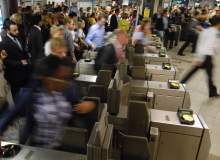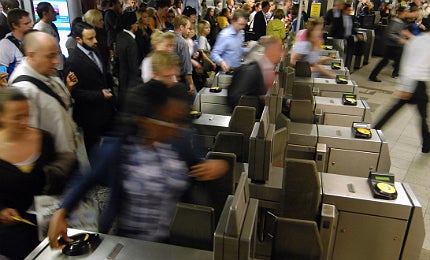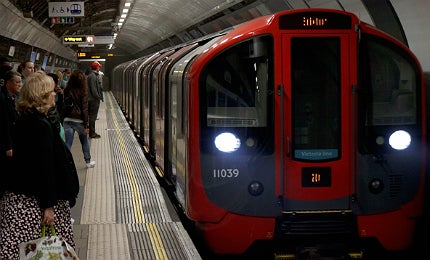

For many passengers, commuting on a busy underground metro system brings them a little closer to their fellow travellers than they would ideally like. At peak hours, during weekday mornings and evenings, a large proportion of the workforce in the world’s biggest cities can be found crammed into metro carriages, a mass of sharp elbows and bad tempers.
For the busiest metro systems around the world, improving passenger flow and mitigating the misery of the rush hour is a top priority. The UK’s London Underground (LU), the world’s oldest underground railway, is no exception. The Tube carried more than 1.17 billion passengers in 2012/13, placing it in an elite group of metros regularly serving more than a billion customers a year. And unlike many other metros, LU has to increase capacity and modernise services on a system that, in some sections, has been operating for 150 years.
We talked to London Underground’s director of capital programmes David Waboso to discuss the ongoing issue of rush hour overcrowding and boosting capacity to keep up with ever-increasing demand.
Chris Lo: Could you describe the daily challenges that LU faces when it comes to dealing with rush hour crowds?
David Waboso: Although morning peaks are the network’s busiest period, increasingly evenings and weekends are experiencing challenging levels of demand, driven by the growth of London. TfL [Transport for London] figures show that 75% of commuting trips are made by Tube in the morning. The system is operating intensively at capacity, so a single interruption can quickly create a domino effect of delays.

US Tariffs are shifting - will you react or anticipate?
Don’t let policy changes catch you off guard. Stay proactive with real-time data and expert analysis.
By GlobalDataFor example, it’s not uncommon for customers to be taken ill on a train – that in turn can lead to a train being held in platform for a few minutes, while help is summoned, during which time the time between trains has stretched from a minute and a half to three or four minutes, allowing platforms to overcrowd and causing queuing at the busiest stations.
We’ve already made fantastic inroads into improving reliability, at the same time as carrying record numbers of passengers, upgrading the network and keeping some of the oldest trains and signalling in Europe going until they too can be replaced. But we’ve got to see continued investment alongside our will to think differently, so that we hit the new heights of performance necessary to keep London working.
CL: What is LU’s overarching strategy for reducing overcrowding during commuting hours?
DW: Although we have some peak pricing, such as concessions and cheaper Oyster fares after 09:30hrs, our plan to reduce overcrowding is to increase reliability and capacity of the service.
LU has old, small tunnels, so we can’t make the train much bigger. That means the main way to increase capacity is to increase the frequency of trains – we recently introduced a 33 train per hour [tph] timetable on the upgraded Victoria line – and new investment across the network is essential if we are to keep pace with demand. Some of the most important parts of the network are in urgent need of upgrading – we are only able to operate 24tph on the Piccadilly line for example, the vital line that serves Heathrow, King’s Cross and London’s West End. We’re also investing to increase capacity at key interchanges like Victoria, Tottenham Court Road and Paddington.
During the [London Olympic] Games we saw how effective travel demand management could be – working with businesses to retime the working day, and giving passengers information about where the peak demand was likely to be so they could find alternative routes.
But with the Games over, the trick now is to see how we can use that experience to help customers use our network differently. Even retiming journeys can make a significant difference on parts of the network – for instance, if we can incentivise people on the Northern line between Clapham South and Kennington to re-time their journeys, we can unlock unused capacity. We’re working to explore this more, currently focusing on London Bridge and working with Network Rail, the train operating companies and others to see how best to manage passenger flows during the extensive works there over the next few years.
CL: New capacity expansion projects like Crossrail are obviously vital to reduce overcrowding – what other projects are in the pipeline to increase capacity?
DW: The Tube’s line upgrades recently completed or in progress cover the Jubilee, Victoria, Northern, Metropolitan, Hammersmith & City, District and Circle lines, and will increase capacity by around 30% across the network over the next five years. Additional cars on the London Overground will increase capacity by 25% by the end of 2014.

The Victoria line runs 33 trains an hour
Longer-term, it is essential that we have new trains and more capacity on the Central, Bakerloo, Piccadilly and Waterloo and City lines to complete the upgrade programmes. We are looking to further increase capacity on the Jubilee and the Northern Lines, exploiting the capability of the new signalling systems through buying more trains and operating different service patterns.
This is essential to cope with extra demand, for example at Euston with the arrival of the HS2 train service. In the long term we will need additional lines, once the investment in the existing infrastructure is complete, such as Crossrail 2, which is proposed to run north-south across London.
CL: At this point, do you think expansion projects are just a way of keeping pace with increasing demand, or do you think sustained investment in Tube services could actually ‘get ahead’ of that demand?
DW: Our planning for expansion projects looks ahead at forecast growth rather than just addressing the immediate needs. For station projects, we typically design for expected growth over the next 50 years. Many expansion projects have a long gestation period – a major upgrade of a whole line can take in excess of ten years to plan and deliver, so sustained investment is essential to be able to plan and deliver efficiently. Evidence has shown that the more service we provide the more demand grows.
CL: How carefully do you consider the trade-off between the improvements upgrade projects bring to services and the inconvenience they could cause to passengers?
DW: We give great consideration to the balance between the short-term disruption of projects and the long-term benefits. Our starting point for any project is to see if we can deliver the benefits without disrupting normal services. The current Northern line upgrade is being delivered with very few closures and inconvenience to passengers, through innovative designs and working practices, but that won’t always be possible.
Where we need to make major structural changes to stations or track infrastructure, these can’t be completed in the three or four hours when we close down the system. Invariably there’s a balance we have to make between the least disruptive works and the cost of delivery, which can increase through doing piecemeal works which might compromise the ultimate benefit to customers.
CL: Other than expansion projects, how can technology be used to improve efficiency of services and passenger flow? Could you ever see the Tube employing driverless technology?
DW: We are already exploiting technology in many areas of our investment programme. New signalling systems are allowing trains to run faster and more frequently, rather than rely on ‘fixed block’ technology. Sophisticated analysis tools are built into the new trains to diagnose performance and allow quicker response to faults.
Changes to our ticketing are allowing easier and quicker payment for journeys. Using Oyster cards rather than paper tickets allows passengers to pass through gates quicker, and we are now exploring the use of contactless cards to further simplify and speed up the passage through the gates.
Information provision has developed at a rapid rate in the last few years and, with wi-fi available on most of our stations, and apps available on smartphones, passengers have easier access to real-time information, which can help them make informed decisions about their travel to avoid congestion. We are committed to looking at all technology, even driverless trains. Three quarters of new metros are built driverless; there are many technical hurdles to overcome before such a technology could be contemplated on London’s tube lines, however we are exploring all options.
CL: With major Tube stations being redeveloped as part of the Crossrail project, is it a good opportunity to use innovative station design to improve passenger flow and minimise bottlenecks in stations?
DW: Yes – we have major improvement projects in progress at Victoria, Tottenham Court Road, Bond Street and Paddington, as well as designs in progress at many others. Many of these are joint LU / Crossrail stations, where we are using the same design principles on both LU and Crossrail stations.
The opportunities created by Crossrail, in terms of space and budget, create a once-in-a-lifetime opportunity to make a major improvement to stations. Quite often our ability to make such extensive changes to existing stations is limited by space and funding constraints.
Related content
UK rail: measuring passenger satisfaction
Two recent UK surveys have presented seemingly contradictory reports on rail passenger satisfaction.
HS2: on the right track?
The UK Government is pushing ahead with HS2, recently announcing the route for the second phase of its ambitious high-speed rail project.



